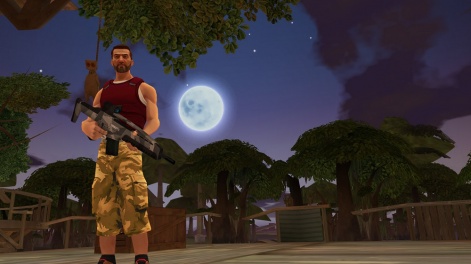The last entry in Gameloft's open-world Gangstar series, Gangstar Vegas, was launched back in 2013.
A paid game, as had been its four predecessors before it, Gangstar Vegas was one of the last Gameloft games to launch with a premium model.
Vegas had in-app purchases too, and is now being offered as a free-to-play experience. But since January 2015, Gameloft Montreal has been working on a sequel designed from scratch for F2P.
The result is Gangstar New Orleans, which soft-launched in the Philippines back in January 2017 and is set for global launch on March 30th.
“It's been a long ride,” says the game's Producer Robin Gazaille.
“[The series] has always been very successful for Gameloft - lots of players are still playing Gangstar Vegas today - but we never really had a Gangstar built from the ground up as free-to-play.
“In earlier Gangstar games, people could burn through content very fast. You could pay $7 for the game, and through a few IAPs basically skip time, skip missions, get all the best cars and all the best weapons.”
The key difference with Gangstar New Orleans, then, is Gameloft's stated aim to create a world in which players can “spend years”.
Long-term plan
Its approach to this has been to build a world nine times bigger than any previous Gangstar games: a version of New Orleans that incorporates all of its most iconic landmarks.
We're leading the way in terms of having an open-world, free-to-play game on mobile.Christopher Budgen
“We can create different moods for different districts, and we really want the player to be inside this world and living it,” explains Art Director Gabriel Villatte.
Another key part of creating an experience with lasting appeal has been the introduction of the asynchronous PvP Turf Wars mode, in which players tussle for control over territory.
However, Gameloft Montreal makes no secret of the fact that building a free-to-play open-world game on mobile is uncharted territory - and with that come complications.
“We're leading the way in terms of having an open-world, free-to-play game on mobile - it's difficult sometimes to marry those concepts,” Game Director Christopher Budgen tells PocketGamer.biz.
“We really tried to understand what's motivating for players overall… We don't want the free-to-play model to be fighting against the motivations that our players are carrying with them.”
Let them play
As such, after iterating on a few monetisation models throughout development, the team decided fairly quickly that any system built around limitation of play would detract from the inherent appeal of an open world.
“We do have our previous Gangstar titles, so we can see that time spent in free-roam, in a sandbox, is a place where players are very happy,” says Budgen. “So we didn't want to take that away.
“We didn't want, when creating the free-to-play model, to force players out of the title. We wanted to try to match that experience of playing the game, playing the missions, playing the sandbox and having that core loop work together - but not constantly trying to say 'you're done now, you don't have to play anymore'.
“We want the players to basically inform us what is the way they want to consume our content.”
Gazaille gives the example that players can “send one of their thugs to do the mission for them,” or spend hours playing missions and free-roaming.
Learning from players
As well as identifying bugs and stability issues - a major undertaking in such an ambitious project - the soft launch period has also proven invaluable in informing Gameloft about these player habits.
One of the things people loved most was actually wreaking havoc and causing mayhem.Jean-Pierre Valery
And while players have reportedly been engaging with more mission content in Gangstar New Orleans than in Vegas, the appeal of playing around in the sandbox remains significant.
“We learned that one of the things people loved most was actually wreaking havoc and causing mayhem in the city, so we created a game mode called Mayhem,” reveals Product Manager Jean-Pierre Valery.
This mode is a direct result of player trends identified in soft launch, allowing players to rack up scores and compete on leaderboards for the amount of destruction caused - thus bringing additional thrust and meaning to a previously aimless activity.
Blue ocean - but for how long?
An increasingly dominant genre in the console space, open-world stands out as an area of as-yet unfulfilled potential for free-to-play mobile developers. Will Gangstar New Orleans be the start of a trend?

“For us, that remains to be seen,” considers Budgen. “We do believe that this is a market that our players are interested in, and we've seen through our previous Gangstar games that players love open world on mobile.
“Whether other people choose to also choose to jump into it - it's obviously a major investment and a lot of work - we feel it's definitely going to be worth the investment.”
After more than two years in development and a team that's larger than on previous Gangstar titles, Gameloft - and Vivendi - will certainly be hoping that's the case.




















